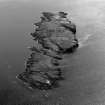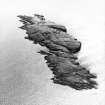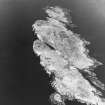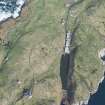Isle Of May, New Lighthouse
Lighthouse (19th Century)
Site Name Isle Of May, New Lighthouse
Classification Lighthouse (19th Century)
Alternative Name(s) May Island; Isle Of May Ii
Canmore ID 57880
Site Number NT69NE 8
NGR NT 65500 99364
Datum OSGB36 - NGR
Permalink http://canmore.org.uk/site/57880
- Council Fife
- Parish Anstruther Wester
- Former Region Fife
- Former District North East Fife
- Former County Fife
NT69NE 8.00 65500 99364
Lighthouse [NAT]
OS 1:10,000 map, 1976.
NT69NE 8.01 NT 65082 99953 North Horn
NT69NE 8.02 NT 65961 98830 South Horn
NT69NE 8.03 Centred NT 65679 99182 Keeper's Cottage, Coal Store and Stable Block
For predecessor beacon ('Old Lighthouse') at NT 65554 99386, see NT69NE 3.
For Low Lighthouse and cottages (NT 65489 99599), see NT69NE 6.
See also:
NT69NE 14 NT 6590 9909 Kirk Haven, Jetty
ENGINEERS: Robert Stevenson, 1816.
(Undated) information in NMRS.
The new (present) light on the Isle of May was completed in 1816, the design of its castellated tower reflecting the influence of Sir Walter Scott. It is one of the best examples in Britain of a lighthouse built in the grand manner on an unencumbered site unfettered by the austere functionalism necessary on a wave-swept rock. Here, the Northern Lighthouse Board erected a showpiece establishment suitable for entertaining the Board on inspection visits.
The square residential block is built on two floors; the flat roof has recently been renewed. Its corners are strengthened by shallow projections, and the tower of three stages is set forward to emphasise its vertical lines. The main front (which has a central pointed doorway) and the entire tower are of ashlar; the remainder of the walling is of rubble. Although the general effect is pleasing, a purist might find minor faults in scale. The interior is impressive, and perhaps the greatest surprise is the fine open-well newel stair which has a mahogany handrail, and until recently had a carpet. This gives access to the first floor and all the principal rooms, some of which contain original furniture, china and silver.
The actual (present) lantern dates from 1924, but the lower part is as built and is complete with such fittings as the original brass clock (dated 1816) and the barometer. The present lighting is by vaporising oil, and dates from 1924 when it replaced an electric arc-lamp installed in 1886. This in turn had replaced the original Argent oil-lamps and reflectors.
Although not as early as Dungeness [Kent], where the first electric light was displayed as early as 1862, the electric apparatus from the May is of interest, and is preserved in the Royal Scottish Museum [National Museum of Scotland]. The electric light worked well, and proved powerful, but was replaced on grounds of economy. The steam engines that drove the generators were coal-fired, requiring the services of seven keepers as against the present three. The small freshwater loch [NT 6588 9921] was enlarged to supply condensing water.
These engines were replaced by diesels, which supply air to the foghorns (NT69NE 8.01 and NT69NE 8.02 ) through heavy cast-iron pipelines.
D [B] Hague 1965.
This lighthouse became a 'rock' station in 1972, when the keepers' families were landed from the island.
R W Munro 1979.
Name cited as: Isle of May, Summit.
[Admiralty] 1980.
The Isle of May electruc light was first lit on 1 December 1886. Its installation required a substantial increase in the number of keepers; new houses were built as well as an engine house, a boiler house, a coal store and a workshop. It proved so labour-intensive that it was reconverted to oil in 1919.
K Allardyce and E M Hood 1986.
Name: Isle of May II (1814-16)
Location: N56 11 W2 33 Firth of Forth, 12 miles N of Dunbar
Designed and built: Robert Stevenson
Light first exhibited: 1 February 1816
Description: square stone tower in gothic style rising from square accommodation
Height of light above MHW: 239ft (73m)
Height of tower: 78ft (24m)
Light source and characteristics: Fixed white, now W Fl (1) ev 20 secs. 250W mercury vapour lamps: 1,250,000 cp: 22nm nominal range
Fog warning apparatus: Siren (4) ev 135 secs
Manning: unwatched (automatic since 31 March 1989), monitored from Northern Lighthouse Board HQ, Edinburgh
Replaced original lighthouse (1636): Listed
C Nicholson 1995.
This lighthouse is situated on the highest point of the island, from where it guards the entrance to the Firth of Forth.
Information from RCAHMS (RJCM), 1 May 2006.
Note (1 May 2006)
This lighthouse is situated on the highest point of the island, from where it guards the entrance to the Firth of Forth.
Information from RCAHMS (RJCM), 1 May 2006.
Project (2007)
This project was undertaken to input site information listed in 'Civil engineering heritage: Scotland - Lowlands and Borders' by R Paxton and J Shipway, 2007.
Publication Account (2007)
TThe Isle of May at the entrance to the Firth of Forth, about one mile long and one-third of a mile wide, for centuries resulted in the shipwrecks of many vessels plying to and from the Forth ports, a situation which led to the erection there of the first lighthouse in Scotland (NT69NE 3). The original coal-fired light was replaced in 1816 by the present architecturally imposing lighthouse reminiscent of a small castle, with accommodation for three lighthouse keepers and their families and visiting officials, designed and erected under the direction of Robert Stevenson. It had a fixed light consisting of Argand oil lamps with parabolic silvered reflectors. In 1836 it was replaced by the first British dioptric fixed light, with novel refractors made by Cookson of Newcastle.
R Paxton and J Shipway 2007
Reproduced from 'Civil Engineering heritage: Scotland - Lowlands and Borders' with kind permission from Thomas Telford Publishers.






















































































































